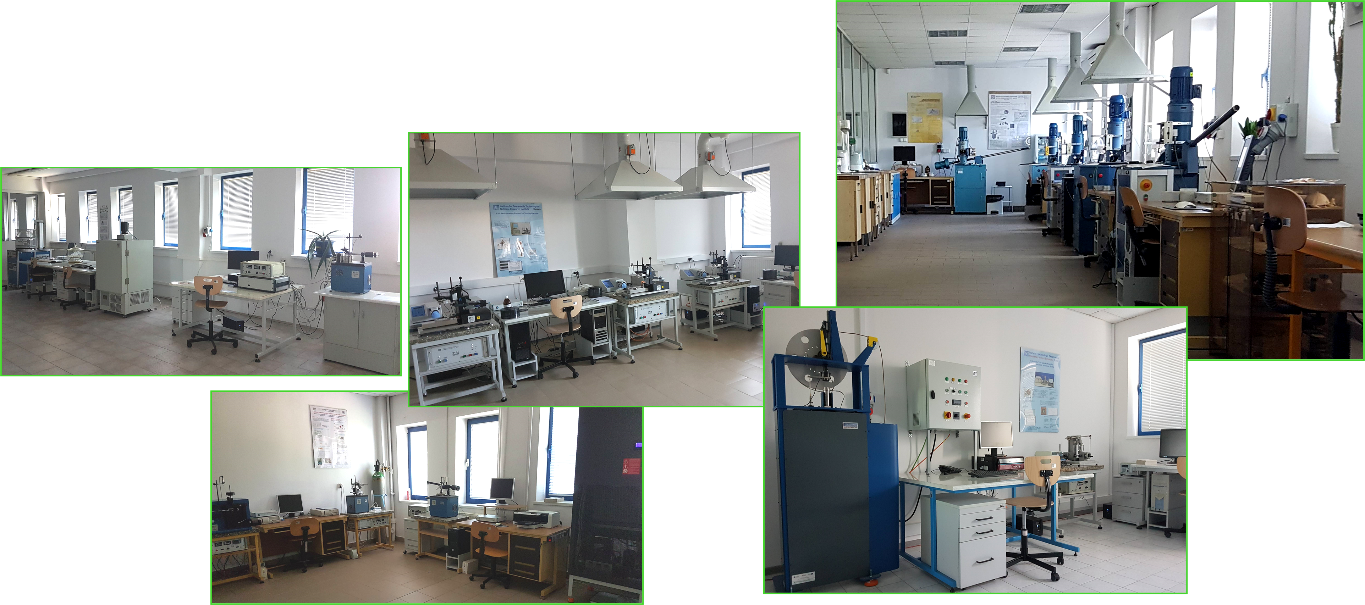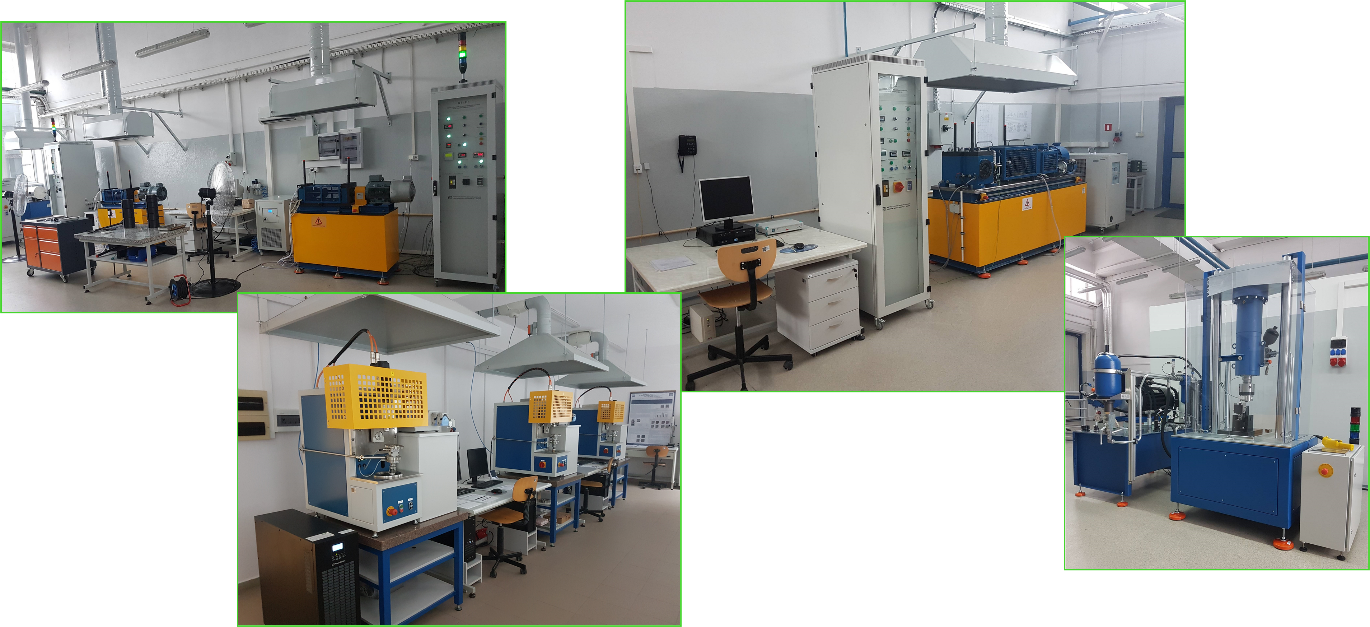Tribology Centre

dr hab. inż. Remigiusz Michalczewski
Head of Tribology Centre
tribologia@itee.lukasiewicz.gov.pl
tel. (+48) 48 364-42-41 ext. 247
dr hab. inż. Daniel Pieniak
dr inż. Edyta Osuch-Słomka
dr inż. Wojciech Łoński
mgr inż. Marek Kalbarczyk
mgr inż. Anita Mańkowska-Snopczyńska
mgr inż. Maciej Łuszcz
mgr inż. Andrzej Snarski-Adamski
mgr inż. Michał Gibała
mgr inż. Jarosław Wulczyński
The activity of the Tribology Centre revolves around the topics of friction, wear and lubrication of machine parts and tool components, and it is particularly focused on research methods and devices. The main areas of the Centre’s activity include the following:
- the analysis of friction and wear processes on a macro, micro and nano scale;
- the development of methods for improving tribological characteristics of machine parts;
- the development of systems for assessment of tribological properties of structural materials and greases; and
- the development or research and test instruments for tribological analyses.
The Centre is equipped with world class tribological test and research apparatus. Within the Centre’s structure there also is a Tribological Research Laboratory accredited by the Polish Accreditation Centre (scope of accreditation: AB 891), as part of which the following organisational units operate: the Scanning Microscopy and X-ray Microanalysis Unit; the Atomic Force, Inteferometric and Optic Microscopy Unit; the X-ray Diffraction and Emission Spectroscopy Unit; and the Metrology Unit.
The Centre cooperates with many Polish and foreign universities and R&D organisations, e.g.: the Krakow, Lodz, Rzeszow, Warsaw, Silesian, Wroclaw and Poznan Universities of Technology; the Kazimierz Pulaski University of Technology and Humanities in Radom; the University of Lodz; the University of Monterrey in Mexico; the University of Malta; the UC Chile; the Institute for Superhard Materials of the National Academy of Sciences of Ukraine; the Federal Institute for Materials Research and Testing in Berlin; the Austrian Excellence Centre for Tribology; and the entral Metallurgical Research & Development Institute in Cairo. The scientific and research instrumentation designed at the Centre and developed at the Institute is used at many Polish universities of technology, research institutes (also incorporated as part of the Polish Academy of Sciences), and industrial laboratories. It is also exported to China, Croatia, the Czech Republic, Egypt, Israel, South Korea, Mexico, Germany, Russia, Hungary, Vietnam, and the USA.
| Type of diagnostics | Diagnostic apparatus | Methods |
|---|---|---|
| Vibration and noise analysis |
Pulse B X11 and B X12 multi-channel vibration and noise analysers Portable vibration and noise analyser |
Own method or to be agreed with the customer |
| Temperature field analysis | Thermographic camera | Own method or to be agreed with the customer |
| Type of research | Analytical/measurement instruments | Analytical/measurement methods |
|---|---|---|
| In the micro scale - surface images and elemental analyses (point, line, area) | SU-70 field-emission scanning electron microscope (FE-SEM) and NSS 312 energy-dispersive spectrometer (EDS) | Methods to be agreed with the customer |
| In the micro scale - elemental analysis of the material, distribution of elements in the surface layer | JY 10000 RF glow-discharge optical emission spectrometer (GD-OES) | Methods to be agreed with the customer |
| In the micro/nano scale - stereometric images of the surface | Q-scope 250 atomic force microscope (AFM) | Methods to be agreed with the customer |
| In the mili/micro scale - images of the surface | MM-40/L3FA optical microscope | Methods to be agreed with the customer |
| In the micro/nano scale – surface roughness measurement and stereometric images of the surface |
CCI interferometer Form Talysurf PGI 830 stylus profilometer |
Methods to be agreed with the customer |
| In the micro scale – microhardness measurement | FM-800 microhardness meter machine | Methods to be agreed with the customer |
| In the micro scale - phase and physico-mechanical (stress) analyses | XRD D8 DISCOVER X-ray diffractometer | Methods developed at Łukasiewicz-ITEE |
| Hardness measurement | KP 15002 P hardness meter machine | Hardness scales: HB (PN-H-04350:1978), HRA, HRF, HRB, HRC |
The Tribology Centre is open to organizing and conducting research internships for people from Poland and abroad, in particular for:
- students of technical universities, preparing engineering and master's theses
- PhD students
- research staff of technical universities
- employees of the industry sector, preparing doctoral dissertations
We offer internships in the following fields:
- Tribological tests of lubricants, engineering and tool materials
- Tribological tests of thin anti-wear coatings
- Tribological tests under extreme conditions (vacuum, temperature, loads)
- Milli, micro and nanoscale tribological studies
- Tribological and fatigue tests of gears
- Testing of various forms of wear: scuffing / seizure, abrasive wear, pitting, micropitting, fretting
- Surface analyses
We have experienced scientific and research staff. The internships may be conducted in Polish or English.
We have extensive research and analytical facilities.
Examples of devices for tribological testing on model samples

Examples of component testing devices

Examples of analytical instruments

If interested, please contact the Director of the Tribology Centre.
Centrum Tribologii (poprzednio Zakład Tribologii) posiada bogate doświadczenie w opracowywaniu i wdrożeniach urządzeń do badań tribologicznych - procesów tarcia, zużycia i smarowania.
Przez ponad 30 lat działalności został opracowany i wytworzony unikatowy zestaw 30 typów urządzeń do badań tribologicznych. Są nowatorskie w skali międzynarodowej, częściowo powstałe w ramach uczestnictwa w międzynarodowych programach takich jak np. Program VAMAS - inicjatywa państw G-7 pn. Versailles Programme on Andvanced Materials and Standards. Wiele powstało w ramach krajowych projektów badawczo-rozwojowych. Niektóre urządzenia zostały opracowane na indywidualne zlecenie klienta.
Urządzenia są opracowywane z myślą umożliwienia prowadzenia badań nie tylko wg norm krajowych, ale też najważniejszych zagranicznych – ASTM, DIN, IP, ISO, CEC. Niektóre zostały opracowane z punktu widzenia prowadzenia badań wg metod własnych klientów.
Oryginalność i innowacyjność opracowanych urządzeń przejawia się w blisko 30 patentach oraz ponad 30 złotych i srebrnych medalach oraz wyróżnieniach na światowych wystawach innowacji, wynalazków i nowych technologii – m.in.: Bruksela, Budapeszt, Casablanca, Genewa, Londyn, Łódź, Moskwa, Norymberga, Pittsburgh, Poznań.
Urządzenia opracowywane są w wersji „na stół” (badania na próbkach modelowych), jak również w wersjach „ciężkich”, w szczególności w przypadku badań komponentowych (np. koła zębate, łożyska toczne). W większości posiadają skomputeryzowane systemy sterująco-pomiarowe.
Urządzenie T-11 typu trzpień/kula-tarcza do badań tribologicznych w podwyższonej temperaturze

Stanowisko T-30 do tribologicznych badań kół zębatych stożkowych

Symulator T-31 do badania tarcia i zużycia spodów obuwia

O wysokiej jakości urządzeń świadczy to, że wiele z nich zostało wdrożonych w dużych przedsiębiorstwach przemysłowych, np.: LOTOS Lab, PKN Orlen, Enea, „Azoty” Tarnów, Silesia Oil. Praktycznie wszystkie krajowe wyższe uczelnie techniczne posiadają opracowane i wytworzone w Instytucie urządzenia badawcze, podobnie jak wiele instytutów badawczych, a także uniwersytetów. Obecnie liczba wdrożeń aparatury to ponad 200. Mamy wdrożenia zagraniczne - w Chinach, Chorwacji, Czechach, Egipcie, Izraelu, Korei Płd., Meksyku, Niemczech, Rosji, USA, na Węgrzech i w Wietnamie.
Jesteśmy otwarci na opracowywanie kolejnych urządzeń do badań tribologicznych. W razie zainteresowania prosimy o kontakt z Dyrektorem Centrum Tribologii.


